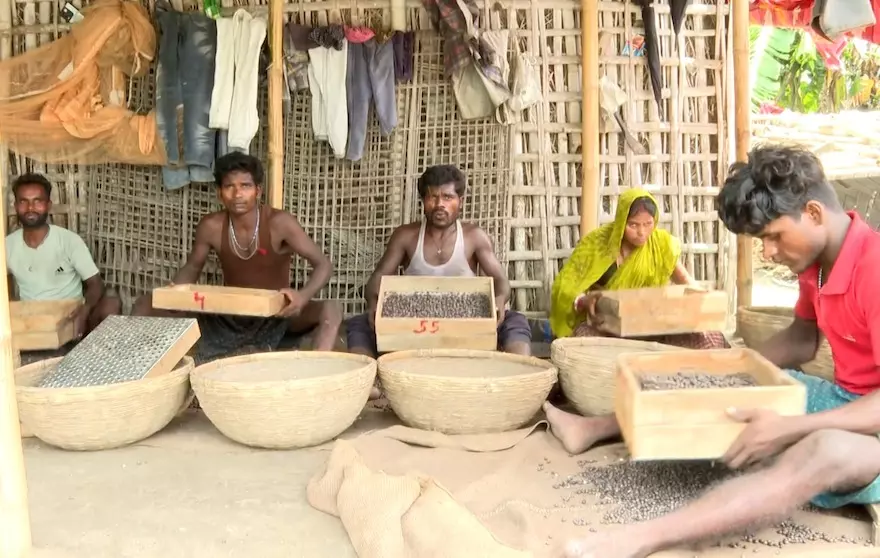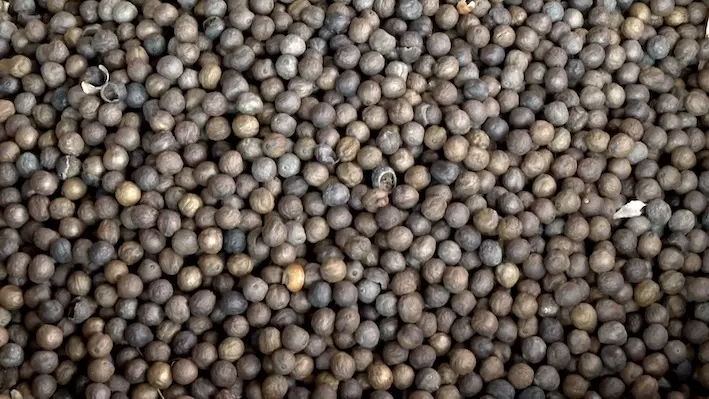
- Home
- India
- World
- Premium
- THE FEDERAL SPECIAL
- Analysis
- States
- Perspective
- Videos
- Sports
- Education
- Entertainment
- Elections
- Features
- Health
- Business
- Series
- In memoriam: Sheikh Mujibur Rahman
- Bishnoi's Men
- NEET TANGLE
- Economy Series
- Earth Day
- Kashmir’s Frozen Turbulence
- India@75
- The legend of Ramjanmabhoomi
- Liberalisation@30
- How to tame a dragon
- Celebrating biodiversity
- Farm Matters
- 50 days of solitude
- Bringing Migrants Home
- Budget 2020
- Jharkhand Votes
- The Federal Investigates
- The Federal Impact
- Vanishing Sand
- Gandhi @ 150
- Andhra Today
- Field report
- Operation Gulmarg
- Pandemic @1 Mn in India
- The Federal Year-End
- The Zero Year
- Science
- Brand studio
- Newsletter
- Elections 2024
- Events
How Makhana cultivation in Bihar leaves farmers struggling for survival
The cultivation of Makhana, branded as a superfood with a GI tag and booming export demand, brings low returns and fading hopes for thousands of farmers across Bihar’s Mithila, Kosi and Seemanchal regions

“I buy a pond for a lakh and a half. I sow the makhana seeds (also known as lava). For six months, I put in everything I have. And when the season ends, my savings are no more than twenty-five thousand rupees.” That is how Devsundar Kumar, a middle-aged farmer from Katihar (Bihar), lays out his arithmetic. His voice is matter-of-fact, but his calculation lands heavy: months of...
“I buy a pond for a lakh and a half. I sow the makhana seeds (also known as lava). For six months, I put in everything I have. And when the season ends, my savings are no more than twenty-five thousand rupees.” That is how Devsundar Kumar, a middle-aged farmer from Katihar (Bihar), lays out his arithmetic. His voice is matter-of-fact, but his calculation lands heavy: months of relentless work for a fraction of the return. As he explains the sums and subtractions of makhana cultivation, one can’t help but wonder: what does this math look like for the countless other farmers who tie their lives to makhana (fox nut or gorgon nut), wading daily into the waters?
To answer that, you have to picture three regions of Bihar where makhana — the nutritious and low-fat snack, rich in carbohydrates, protein, fibre, and minerals like calcium, magnesium, iron, and zinc — has long been the bread and breath of rural life. They include: Mithilanchal region (mainly the districts of Darbhanga, Madhubani, and Sitamarhi); Kosi region (chiefly Saharsa and Supaul), and Seemanchal region (Katihar, Purnea, Kishanganj and Araria). It’s in these three key belts where makhana is grown across nearly 35,000 hectares of wetlands and ponds, tended by an estimated 25,000 farmers.
The Federal’s team was recently in Bihar to cover a political campaign trail, capturing moods and voices of the locals ahead of Assembly elections. But it was the ponds along the roadside — green waters filled with floating crops — that pulled us in. These waters carried the backbreaking labour that ends up, silently, in our kitchens and drawing rooms in Delhi, Mumbai, Kolkata or Chennai. The popped, puffed makhana you toast in ghee or serve to guests at Diwali — this is where it begins. Here, farmers sink waist-deep into the mud, scrape out the hard black seeds, roast them over fire until they burst, and hand them up the chain. What arrives in a glossy supermarket packet as a “superfood” is first wrestled out of slime and thorn.

Thousands of farmers toil in ponds for months, but the global demand for Makhana has not translated into fair prices or secure livelihoods. Photo: Lalit Rai
As we moved forward, a small tempo caught our eye. It was loaded with bamboo baskets, with men perched on top. We stopped them and asked what they did. The answer came without hesitation: “We work in makhana cultivation.” For us, it was like stumbling on gold—suddenly, the questions in our minds had found the people who lived their answers. The farmers in the tempo were heading to Dalkhola, a town across the border in West Bengal. Why there, we asked. The reply came from Gyanu Mahaldar: “Sahib, we get a little more money there. Families need to be fed. This is the season to earn. So we go.”
Ramesh Kumar, sitting beside him, elaborated: “Look, for six to seven months, every day, we spend five to six hours in water. On average, we collect about ten kilos of makhana. The owner pays us fifty rupees a kilo. But here’s the catch: for every ten kilos we collect, we’re only paid for five. Which means our daily earning is just 250 rupees.” As he spoke, his colleague Surendra shifted beside him. His feet bore sores; his hands were riddled with thorn scars. When we asked how this happened, he replied quietly: “Sahib, when you stand in water for six hours a day, every day, what else do you expect?” Ramesh added almost with a sigh: “This is life.”
Also read: How ragi and jowar rotis, a village staple, became urban superfood in Telugu states
In the Union Budget 2025–26, Finance Minister Nirmala Sitharaman had announced the establishment of the Makhana Board in Bihar, aimed at enhancing production, processing, value addition, and marketing of the crop. The Board comes with a proposed budget of Rs 100 crore, targeting multiple intervention areas, including farmer training, infrastructure, organised markets, declining intermediaries, and export facilitation.
When asked about the Makhana Board, the men exchanged glances. “We’ve heard of it,” Gyanu admitted, “but what benefit do ordinary farmers get? Governments say they’ll change our picture. The picture has not changed. All we want is steady work for the season so that the household runs. If the Board brings us real change, we will wait for it.” In his words lay a contradiction: clinging to hope even when faith has thinned.
Further along, in Purnia’s Ranipatra, we met another farmer, Praveen Oraon, standing in the pond as he worked. “It’s tough,” he admitted, “but we’re not weak. We’ve made it part of our lives.” When asked how much he earned in a day, he surprised us: “A thousand rupees.” We pressed him. Other farmers had spoken of only 250 rupees. How was his figure so different? Oraon smiled: “It depends on the contractor.”

While makhana finds its way to gourmet kitchens, those who farm it are left with swollen legs, scarred hands, and meagre pay. Photo: Lalit Rai
Devsundar Kumar, who is also a contractor, explained further: “Things have changed a little. Farmers now get more than before. For a normal pond that yields six to seven quintals of makhana in half a year, I pay the owner a lakh and a half. Larger ponds cost more. Labour rates depend on demand and supply. If there aren’t enough workers, the wage goes up; if there are too many, it falls. The system still needs better organisation.”
Later, we sat with Rupesh Mahaldar and his wife, Julie. The answers were the same, shaded by exhaustion. Rupesh said: “This is a laborious trade. Right now, the market rate is low. Last season, we sold at Rs 1,000 a kilo. This year it’s down to Rs 750. We wait for it to rise.” Julie added quietly: “Sahib, you should know how hard this is. Every day we begin at four in the morning. The work continues till nine at night. There is nothing else we can do. It’s enough to survive, but not enough for a better life. Government schemes? Some benefits reach us. But most of us are not educated. The big contractors and traders tell us what to do, and we have no choice but to follow.”
Globally, makhana has been rebranded as a “superfood.” Nutritionists recommend it for weight loss, for diabetics, for heart health. Wellness companies package it in flavours from peri-peri to Himalayan pink salt and sell it as an artisanal snack. But the global demand has not translated into security for those who actually produce it. The farmers’ world is still one of leased ponds, precarious wages, and constant debt.
Also read: ‘Dead’ voters walking in Bihar, hundreds deleted from rolls in villages near Patna
Even when prices rise in wholesale markets, most of the value is skimmed off long before it reaches the pond. In 2022, makhana received a Geographical Indication (GI) tag for Bihar, recognition of its uniqueness and heritage. Government reports list it as an export-worthy crop. Yet on the ground, farmers wade through the same stagnant waters as their fathers and grandfathers, carrying forward labour that feels timeless but not rewarding.
The Centre’s attempts to operationalise the Makhana Board has been rather slow. According to reports, Union Agriculture Minister Shivraj Singh Chouhan has accepted Bihar’s suggestions, and the process has officially begun. A key stakeholder meeting was held on February 23, 2025, at the ICAR-National Makhana Research Centre in Darbhanga to discuss objectives and roadmap for the Board’s operations.
Notably, CM Nitish Kumar, at a public event in July 2025, highlighted the Makhana Board as one of the critical development initiatives earmarked for Bihar in the latest budget. Recently, Chouhan announced that the Makhana Board is nearly ready and will be operational soon. Importantly, he emphasised that research under the Board will shift to village-based settings, bringing it directly to farmers instead of centralised institutions. Bihar’s Industries Minister Nitish Mishra has argued that the National Makhana Board could unlock investments worth Rs 1.81 lakh crore, streamline certification, and strengthen food processing capacity.

Makhana seeds. For lakhs of farmers, six months of toil turns into just a handful of earnings, even as governments promise boards, schemes, and crores in investments.
However, observers say that the Board remains stuck between the twin claims of Mithila and Seemanchal. Mithila’s centuries-old association with Makhana is officially recognised through the GI tag, making it not just a crop but a cultural marker of identity. On the other side is Seemanchal, led by districts such as Purnia, Katihar, Kishanganj, and Araria, which in the past decade have overtaken Mithila in sheer scale of cultivation. According to the Directorate of Horticulture, Seemanchal alone now accounts for nearly 70% of Bihar’s Makhana output, with over 28,000 hectares under cultivation. Farmers, meanwhile, remain caught in the crossfire.
Many in Mithila insist that the GI tag ties the crop’s identity irrevocably to their soil, while Seemanchal’s leaders counter that geography should follow where the bulk of farmers now till. Purnia has emerged as a compromise candidate, given its location and production weight, but until the Centre decides, the state’s most promising agricultural economy remains in suspended animation.
The story of struggle in makhana cultivation is not just about Gyanu, or Ramesh, or Surendra, or Rupesh and Julie. It is the story of lakhs across Bihar. Successive governments — at the Centre, in the state, across political lines — have made promises of reform, pledges of prosperity. But the ground reality remains unchanged.
For the farmers standing waist-deep in water, cutting their skin against thorns, fighting infections, counting coins after ten hours of labour, hope is both a necessity and a burden. Somewhere in the voices of makhana farmers lingers a quiet prayer: that one day, the toil will be worth more, the numbers will add up, and their faces will carry not fatigue but the calm of contentment. That the crop that travels to five-star hotels and health stores will also nourish the lives of those who bring it out of the mud.
